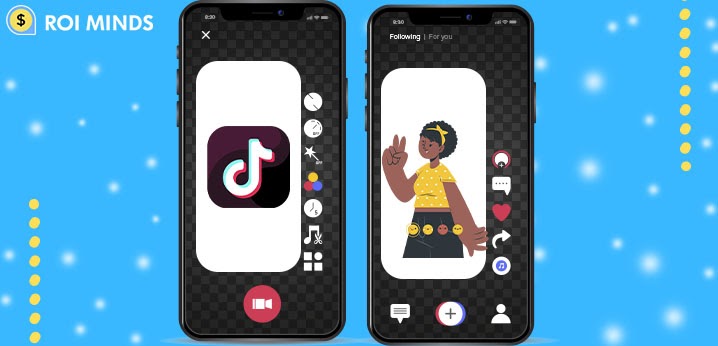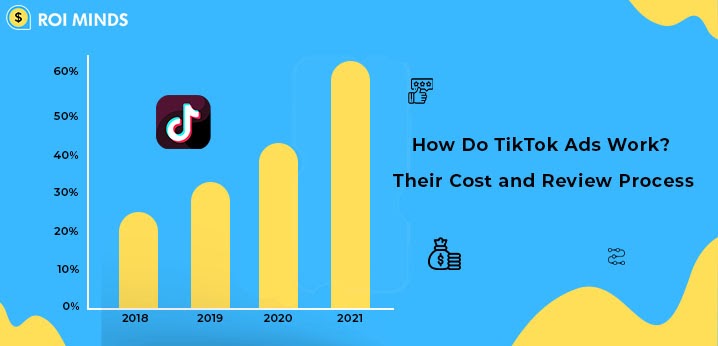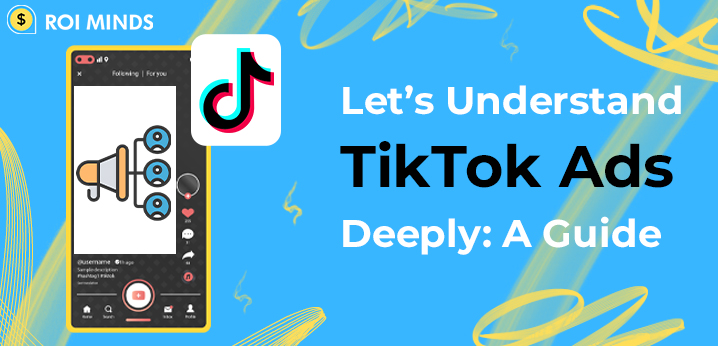Musical.ly, a music-sharing app, was purchased by Chinese tech firm Bytedance in 2018 and merged with the company’s new app, TikTok.
It began as a video-sharing social network in which users posted short clips of themselves lip-syncing and dancing to popular music. It has since grown to house a wider range of videos and serve as a creative outlet for brands.
TikTok’s active user base increased by nearly 800% following the merger. The platform has over 1 billion monthly users, and brands are reaching out to them through TikTok ads.
This article will go over everything you need to know about TikTok’s advertising platform and discuss whether it’s worthwhile to use.
What is TikTok For Business?
TikTok For Business is a one-stop shop for marketers looking to advertise on TikTok. Instead of requiring marketers to develop their strategy, the platform guides them through the entire process of creating advertisements, setting budgets, reaching target audiences, and analyzing campaign data.
The platform’s stated goal is to assist businesses in unleashing their creative side by teaching them how to use the app through their e-learning service and guiding them through the Ads Manager platform.

Types of TikTok Ads
Businesses can only use video advertisements as a marketing format on TikTok. Marketers can create these advertisements using the TikTok For Business Ads Manager platform, and they can choose from five different formats.
#1. TopView Ads
TikTok TopView ads are videos that appear once per day, immediately after a user opens their app for the first time. This is an example of a TopView ad created by the candy company M&M to promote a virtual Halloween experience.
TopView ads can run for up to 60 seconds, longer than the typical TikTok video runtime. As a result, it’s ideal for companies that want to advertise products or services that require longer periods of attention, such as TV commercials.
#2. In-Feed Ads
In-Feed advertisements are videos on a user’s discovery page, also known as the “For You” page. This is the first screen that users see when they launch the app. The TikTok algorithm believes that videos on the For You page will interest the user based on their app activity.
These ads appear as the fourth video in a user’s feed as they scroll through it. This type of advertisement is comparable to those in a user’s Instagram feed. Here’s an example of an In-Feed ad created by GrubHub, a food delivery service.
Because the videos can include a call-to-action, In-Feed ads are especially useful for marketers looking to use TikTok to drive sales conversions (CTA). Acorns, a finance company, used the In-Feed CTA feature to encourage viewers to download their app.
Some brands have created their version of In-Feed ads by directly collaborating with influencers. Raising Cane’s Restaurant, for example, collaborated with well-known TikTok influencer Chase Hudson to promote their restaurant.
#3. Branded Hashtags
Branded Hashtags are advertisements used by businesses to encourage TikTokers to create content centered on a brand-related hashtag of their choice. Businesses that use this ad format have exclusive access to the hashtag, which is unavailable on other social media sites. Its exclusivity comes at a high cost; reported average costs for six days are around USD 150,000.
Assume you own a sportswear company and have recently introduced a new athletic shirt called Blue Shirt. You could make a branded hashtag called #InMyBlueShirt and encourage TikTok users who own your product to post videos of themselves doing physical activities while wearing it.
Jennifer Lopez, a singer, used the Branded Hashtag feature to promote her song, Pa Ti. The hashtag is #PaTiChallenge, and Lopez posted a video of herself dancing, encouraging other TikTok users to participate in the challenge by replicating her dance.
The hashtag #PaTiChallenge has received 2.4 billion views.
TikTok’s Discover page, where users can discover new creators and browse trending hashtags, may include Hashtag Challenges. The Discover page is similar to the Explore page on Instagram.
The Major League Baseball-sponsored hashtag challenge #WorldSeries is featured on TikTok’s Discover feed, and the hashtag encourages users to post videos showing how they’ve celebrated baseball games. When users click on the hashtag, they are taken to an internal landing page that includes the sponsors’ logo, challenge description, and other videos that use the hashtag.
#4. Brand Takeovers
Brand Takeovers are an ad format that combines TopView, In-Feed, and Branded Hashtags. They can also be videos, animated gifs, or still images. The takeover aspect of these ads is that TikTok only features one business per day, with a starting cost of USD 50,000 per day.

Guess a fashion company used TikTok to promote their denim jeans by running a Brand Takeover. Over six days, their TikTok account gained over 12,000 new followers and generated a total engagement rate of 14.3 percent. Top View, Branded Hashtag, and In-Feed ads were all part of their Brand Takeover.
#5. Branded Effects
Branded Effects ads insert images of your products into TikTok videos in 2D, 3D, or AR. Brands typically create stickers or filters of their products for TikTokers to use when creating videos. Because they typically involve playing brand-specific games, these filters and stickers increase engagement and brand awareness.
Puma, a clothing company, advertised their new soccer shoes using the Branded Effects feature. Their 3D sticker prompted users to play a virtual reality soccer ball game. They used their Branded Effects sticker in conjunction with a hashtag challenge, which resulted in over 100,000 videos of user-generated content.
How Do TikTok Ads Work?
It is relatively simple to create a TikTok ad.
First, you must set up a business account from which you will build, manage, and track your ads. The following step describes your company and sets up your payment method.
Now comes the exciting part. There are two ad manager modes to choose from simplified and custom.
In both cases, you create your ad in levels. You start by sketching out your campaign, defining your ad group, and finally creating your ads.
The following is the distinction between these two modes:
- The simplified mode takes a straightforward approach to ad creation, relying on Tiktok’s algorithm to do the heavy lifting.
- The custom mode gives advertisers complete control over their ads, including advanced customization options such as A/B testing, audience targeting based on video and creator interactions, and ad combinations.
You can change modes at any time.
Now that you understand how TikTok ads work let’s go over creating an account and your ad.
How to Set Up Your TikTok Ad Account
- Create a business account.
- Describe your business.
- Enter your billing information.
- Set up your payment type.
- Select your ads manager mode.
- Build your ad.
- Review and submit your ad.
- Create a business account.
- Describe your business.
- Enter your billing information.
- Set up your payment type.
- Select your ads manager mode.
- Build your ad.
Pro-tip: When building your ad, consider Promo, the video marketing tool that allows you to find video templates and create high-quality promotional videos.
- Review and submit.
TikTok Ad Review Process
When you submit an ad for review, it usually takes 24 hours to review. To avoid any delays, you want to make sure your ad meets the platform’s ad requirements and follows its policies.

Here’s a checklist to use when reviewing your ad before submission:
- The landing page:
- Is functional and mobile-friendly.
- Delivers on what it outlines in the ad.
- Matches the product name in the ad.
- Is in the language of the region it’s targeting.
- Doesn’t automatically download files to a user’s device.
- The ad:
- Is free of spelling and grammatical errors.
- Contains audio.
- Is between five to 60 seconds.
- Doesn’t include excessive use of symbols, spacing, numbers, or capitalization.
- Matches the caption.
- Is in the region’s language it’s targeting (or includes subtitles.)
- Doesn’t include any prohibited products or services.
- Is not blurry or pixelized.
- Follows standard video sizes: 9:16, 1:1, 16:9.
TikTok Ad Examples
#1. Fly By Jing
Fly By Jing collaborated with food influencer TiffyCooks in this TikTok ad to show how simple (and tasty) it is to use the brand’s product.
Using a well-known influencer is a great way to increase brand awareness and build trust with your target audience. Another great feature of this ad is that the offer is straightforward: users can save 10% by clicking the CTA and entering the code.
#2. Tiffany & Co.
To promote its latest collaboration with Beyoncé and Jay-Z, the brand has released a series of advertisements featuring the artists. The advertisement is straightforward but effective, and it directs users to a landing page where they can learn more about the campaign.
#3. Omsom
This food brand accomplishes a lot in 20 seconds.
The video effectively demonstrates how the company’s product is used. The caption also provides users with background information about the brand and tells a story in a few words. Furthermore, the CTA directs users to a product page (rather than the homepage) where they convert.
Finally, too often, advertisements appear jarring because they do not fit the feel of the platform. That is not the case in this case. The ad looks so natural in the feed that you’d never guess it was an ad if the #sponsored tag and CTA were removed.
TikTok Advertising Cost
Here’s how much money you should spend on Tiktok advertising. You can set a daily or lifetime budget, which can be adjusted during your campaign.
At the campaign level, you must have a minimum daily and total budget of USD 50, and your daily budget must be greater than USD 20. TikTok has not released its pricing policy for advertising. There is, however, some information available.
TikTok had a cost-per-mille as low as $1 in 2020, according to Digiday. JungleTopp reported that their cost-per-click was $0.19, significantly lower than Facebook and Instagram.
You can select several optimized bidding strategies for specific objectives with this platform.
Should You Leverage TikTok in Your Marketing Strategy?
TikTok has become a preferred advertising platform for many brands since its peak in 2020. The number of ads users saw increased in lockstep with the number of users, rising from 19% in 2020 to 37% in 2021.

According to a Kantar report published in 2021, the short-form video platform surpassed Amazon, Instagram, Google, and Twitter in ad equity. It’s not the first time they’ve held that position – they also did so the year before.
Despite this high ranking, data suggests that marketers are still skeptical of the platform. According to the report, many marketers see TikTok as innovative but untrustworthy.
Many people still prefer to use tried-and-true media platforms like Facebook, YouTube, and Instagram. TikTok is popular among consumers because of its authenticity and sense of community.
According to a 2020 Nielsen survey of global TikTok users, 59 percent said they feel a sense of community when they use the app. It’s also a major source of consumer discovery, with 85 percent of users discovering new content they like on the app.
As a result, the platform’s advertisements are more creative and less “commercial.” According to the study, 68 percent of TikTok users worldwide believe that the platform’s ads are unique and distinct from those on other social media platforms. In Indonesia, that figure rises by 23%.
So, the audience has arrived and is ready to participate. However, the decision to include TikTok For Business in your marketing strategy is ultimately determined by your company’s goals and desired campaign outcomes.
To help marketers make this decision, we’ve compiled a list of pros and cons.
TikTok For Business Pros and Cons
Let’s start off with the pros.
The Pros of TikTok Advertising
What makes TickTock tick? Here are the top TikTok pros that should hook your interest:
#1. Brand Exposure to Millions of Users
With 1.5 billion downloads, TikTok was the third most downloaded app worldwide in 2019, gaining more app store action than Facebook, Instagram, and Snapchat. That number of downloads equals millions of potential customers, with TikTok offering one of the largest social media audiences on the market. If you’re looking for new marketing channels, perhaps it’s time for TikTok?
#2. Chance To Get Creative
TikTok is all about fun, and creating your creative videos is an affordable way to stand out from your competitors. Unless it contradicts your brand image, you should think about going wild with your company’s smartphone or launch a catchy hashtag challenge. Unlike Instagram, Facebook, or Twitter, TikTok allows you to think outside the advertising box, which could help your business go viral!
#3. Reach New Markets
TikTok is available in 155 countries and 75 languages, with most of its users based in the US, China, and India. This user diversity offers the chance for your business to expand to new markets. With such a wide range of available languages on TikTok, you can create effective ads that resonate with almost any audience.
#4. Ads Play Automatically
Your adverts will play automatically to keep the user’s experience ticking along, and with users spending 52 minutes on TikTok per day, you’re guaranteed advert exposure. Your ads will be identified with a “sponsored” or “promoted” tag to maintain transparency with the user base.
Remember that posting too many ads can be annoying for the users. Suppose you’re concerned about what users say about your adverts on social media. In that case, you should think about using a social media listening tool to gain real-time insights into the perception of your brand online.
The Cons of TikTok Advertising
TikTok is flying high, and there’s no doubt about that. But what goes up must come down. Here are the top TikTok cons that you should be wary of:

#1. Expensive Ads
Startups, look away now. TikTok ads are expensive compared to Facebook and Instagram adverts. According to Voluum.com, the average cost of TikTok’s ads are as follows:
- Brand takeover (5 million impressions guaranteed) – $50,000 per day
- In-feed native videos (minimum 600 impressions prepaid) – At least $6,000 and then $10 per impression
- Hashtag challenge – $150,000 per week
- Influencer post (with 2.5 million+ followers) – $600-$1,000 per post
TikTok isn’t viable for cheap and cheerful viral campaigns. Rather, it’s a premium advertising option that demands a relatively large digital marketing budget.
#3. Not Suitable for Audiences over 30 years old
16-24-year-olds primarily use TikTok. The younger generation responds to the platform’s culturally relevant status – remember that TikTok is rife with social media influencers, and it’s often used to create lip-syncing videos to the latest pop tracks. If your main audience is over 25, you might struggle to connect with the TikTok audience. If your customer base is over 30, you shouldn’t bother.
#3. Advert Censorship is Common
Owned by a Chinese company, ByteDance, TikTok has been known to censor videos that could be seen to be firing up the political climate. Since then, the platform has also removed seemingly appropriate videos without explanation. TikTok isn’t known for its customer service, so you are left in the dark regarding advert censorship – which could cost your business a significant amount of money.
Summary
TikTok can be a valuable tool for growth if you incorporate it into your advertising strategy. While the app does require niche content, brands and businesses can diversify their strategy and reach a new audience.
Whatever decision you make, TikTok For Business is available to those who want to capitalize on the app’s advertising potential.





